Abstract
The growing interest within the construction industry in the preservation, rehabilitation, and conversion of heritage-value buildings has led to the implementation of Historic Building Information Modelling (HBIM) across all sectors. The rigorously accurate representation of old construction solutions for roofs, floors, and walls, and of the decorative details and finishes, commonly used in historic buildings of patrimonial value, requires specific geometric modelling processes in order to generate relevant libraries of parametric objects. This study addresses the generation of parametric families of representative architectural geometry in the context of the conversion of a building of patrimonial value. A collection of historical information and a detailed inspection in situ, recorded by means of digital images and sketches with annotative dimensions of the architectural forms, were first carried out to support the accurate representation of the building. Several families of objects were generated, namely, guillotine windows, glazed doors, ornamental stonework, staircases, and handrails, thus creating a reference library for use in further similar building projects. The study improves the potential of the BIM process for its application to buildings with distinctive architecture in the context of the preservation or conversion of heritage buildings.
1. Introduction
The Building Information Modelling (BIM) methodology provides the ability to visualise the three-dimensional (3D) geometric model of a building, and considers the generation, updating, and re-use of all of the information associated with the project, centralised within a digital model [1]. The recognition of the benefits of BIM implementation is transversal to all sectors of the construction industry, and is demonstrated by the ease of communication between members of the design team, supported by platforms of advanced technology, and by the confidence in the information that is manipulated to elaborate the distinct activities related to a building’s construction and operation [2]. The available technology used in the development of BIM projects allows a high level of integration and collaboration between all stakeholders involved in a building’s design.
The BIM methodology includes the process of generating, managing, and transferring information between specialists in the development of projects. The concept on which BIM is based is the generation of parametric models, supported by libraries of objects representative of building components. The most frequently used BIM-based systems allow the input of a wide range of parametric objects of building components, thus enabling their easy adaptation to each case under analysis for immediate application in the modelling of new buildings [3]. After the BIM model of a building has been generated, different types of tasks can be carried out using the model database because it is composed of relevant information, namely, construction planning (4D BIM), the cost estimation of the building project and construction (5D BIM), sustainability or energy studies (6D BIM), building management and maintenance (7D BIM), and the safety of workers or users (8D BIM) [4].
Historic or Heritage Building Information Modelling (HBIM) is designed for use in the preservation of historical buildings and can be used in different technical areas, specifically, archaeology, architecture, history, and engineering [5]. The centralization of information in a combined digital model, and the easy access to its database, contributes to the support of this type of multidisciplinary work. The generation of a BIM model representing a historical or heritage building may also be considered as contributing an important collaborative platform; however, for this purpose, the model must include all of the information required by those specialist professionals.
For a rigorously accurate representation of the architectural geometry and the construction solutions adopted in historic buildings, the libraries of parametric objects available in the most used BIM-based modelling systems are very limited. Regarding HBIM, the main difference in relation to new constructions lies essentially in the need to create families of specific parametric objects. A first collection of historical documents is fundamental to following a proper architectural modelling process. The establishment of appropriate parametric objects requires a specific approach to the identification of the most representative architectural configurations of each epoch [6]. Thus standards, patents, and specifications are essential in the provision of support for the development of new object libraries of elements common to buildings of a similar type [7].
The construction of a historic building normally reveals a sequence of stages, because the building is submitted to different interventions over time, thereby incorporating several architectural trends. To establish the historic evolution of the construction solutions, all of the available documentation must be collected, studied, and then archived, forming the documentation that serves as the basis for the development of projects, whether for the purpose of repair or rehabilitation of buildings [8].
The present text describes the modelling component of an academic research paper concerning the elaboration of a proposal for the refurbishment of a building of patrimonial value located in Lisbon, Portugal [9]. This required an initial task of document collection, followed by a detailed modelling process to generate rigorously accurate geometric forms of elements, such as walls, floors, roofs, windows, doors, staircases, and handrails. The main objective of this work was to generate a library of parametric object families to be used in the selected case study and, eventually, in other similar buildings of the same epoch with an aristocratic characteristic.
2. Materials and Methods
Under the broader term BIM, a recent development that addresses buildings of patrimonial value has been designated Historic or Heritage Building Information Modelling (HBIM). This area of study involves different aspects related to the methodology of collecting the available information; the study of standardization methods for architectural configurations to create libraries of specific parametric objects; the identification of traditional and historical construction solutions; and the methods of archiving the documentation of an as-built model [10]. Restoration or rehabilitation techniques require an interdisciplinary team, composed of specialists in history, architecture, and engineering, who work together to design collaborative projects in which the identity of the building is to be preserved. The generation of a BIM model is essential as the main support for such interdisciplinary work and, in this sense, development of specific parameter families of building elements is an important factor.
The method presented in this work has three phases and six main activities (Figure 1). The objective of the first phase (Proposal Selection) is to define the best reuse proposal of a heritage building. Studies were found in the scientific literature regarding heritage building reuse for culture heritage valorisation, and the choice of the best option [11]. A Heritage Building reuse proposal may be selected considering the following criteria: law and regulatory requirements, the eight points of modern restoration [12], cost, sustainability, time to realization, and profitability. These criteria were selected from those used in previous scientific studies [13,14,15,16,17,18,19].
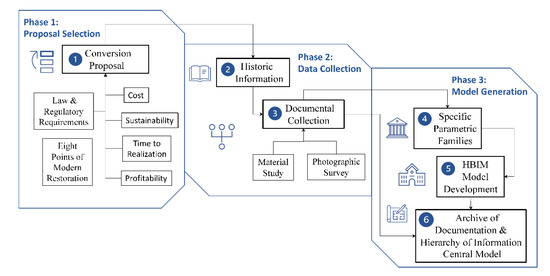
Figure 1.
Development of specific parametric families for an HBIM library in the context of the conversion of a building of patrimonial value: general phases.
Phase 2 includes all data collection activities needed to develop an HBIM model. To define a faithful model of the building under analysis, an initial collection of all relevant historical information, particularly old documents, is needed, followed by the study of past construction processes, and the identification of the materials applied and their physical properties [8,20,21,22,23].
For the development of an HBIM project, the current modelling systems are not fully suitable for the preservation of historic buildings because they do not incorporate parametric objects or historical materials that can be directly applied to the generation of the geometry and composition of the BIM model of the building. Thus, preparatory work is needed in order to collect or capture the architectural form presented in each real building, the identification of the chronologic historical stages of its construction, and the characteristics of the materials applied at the time. The basis of a heritage study normally consists of sets of photographs taken on site, sketches drawn at the location, written documentation and reports of previous inspections, and old drawings available in municipal archives and institutes. Currently, this collection is complemented by the capture of digital images obtained using 3D laser scanner equipment or drones [24,25]. Quattrini et al. [26] states that one of the fundamental requirements in HBIM representation is the exact characterization of architectural forms, demanding the identification of the type of configuration, for its subsequent characterization through new parametric objects. However, for each concrete building, particular parametric objects must be generated because they are difficult to standardise in historic buildings [27].
The Civil Engineering Museum of the University in Lisbon preserves the memory of technological evolution related to the field of construction via a set of exhibits that identify a diversity of remarkable eras of discoveries, positive steps of progress, and maturity [2]. The museum contains several objects related to historical construction work (Figure 2): a wooden model representing a typical door of buildings of the early-19th century, presenting detailed and faithfully reproduced wood-work; a set of plaster models characterizing Doric, Ionic, and Corinthian styles of ancient Greek architecture; a segment of a traditional mud wall, identifying an old construction solution of walls, based on earth, natural fibre, and mortar; and a sample of the old reinforced concrete first applied in Portugal. These samples, available in a technical museum, can be studied by professionals involved in heritage preservation activities, with the aim of analysing forms and materials applied in old construction systems.

Figure 2.
Pieces of the Museum of Civil Engineering, University of Lisbon (Sampaio, 2017a).
In buildings of remarkable architecture, such as those of the Gothic or Romanesque periods, it is possible to identify elements with the geometry generated by revolutionary operations of a specific typology or by the copy of patterns comprising complex shapes (Figure 2). According to [28], HBIM offers a different perspective to BIM, in which interactivity with the parametric object should make it possible to correctly represent the architectural elements, such as columns, capitals, or arcs. Thus, libraries of a wide generalised use have already been created and catalogued, which allows their reuse in an HBIM modelling context. The architecture of the historic buildings is normally based on an overlap of architectural elements. These can be subdivided and represented by sets of basic shapes, which are governed by geometric transformations of regular or parametric curve generation (Figure 3) [26].

Figure 3.
Repetitive shapes detected in historical monuments.
Specification of parametric families of architectural objects, HBIM model development, and Archive of Documentation and Hierarchy of Information Central Model activities are completed in Phase 3. Historical building monuments can be seen as a juxtaposition of components that incorporate changes that succeed each other over time, and that were copied from new constructions, partial ruins, or demolitions. The application of the old material is a testimony to the history of the building, which must be understood through the perspectives of scientific, cultural, and ethical studies [29].
In recent years, researchers have recognised that BIM can play an important role in the holistic organization of models and information. This framework must be designed for HBIM, considering the specific case of documentation of architectural heritage. Because the preservation process of heritage buildings requires a deep level of knowledge, from its initial stages, the design must focus on the aims of preservation, restoration, and the management of the whole process, thereby developing coherent models whose accuracy matches the complexity of the architectural heritage [30,31].
3. Case Study—Mid-19th Century Palace
3.1. Phase 1 Proposal Selection
The academic research work of Pinto [9] concerns the refurbishment proposal of a heritage house. The selected case study is a building, the “Casal de São José”, constructed in the mid-19th century, and situated in an affluent area of the city of Lisbon (Figure 4). The proposal is for the conversion of the building into four apartments, which involves an internal reorganization. This reuse proposal was selected considering the seven proposed criteria shown in the Methodology section. The aspect addressed in Pinto’s work, concerning only the geometric factor, includes, essentially, the tasks associated with the modelling process; the gathering of graphic and written documentation available in municipal collections; the generation of specific families of parametric objects; the definition of ornamental and finishing elements applied to the façades; and the modelling of specific walls, floors, and roofs.

Figure 4.
Images of the front and rear façades of “Casal de São José” [9].
3.2. Phase 2 Data Collection
3.2.1. Historic Information
The HBIM context encompasses the initial process of study, the historic contextualization of the building, the mastery of traditional technologies and materials applied in the old construction, and the archive and management of all information collected and created. A building of patrimonial value usually bears witness to a history of transformations made over time, motivated by different architectural influences and the changes imposed by housing reconversions required by successive owners. The documentary information, recorded in old drawings found in municipal public entities, provides relevant data regarding the characterization of the building (historical epoch and construction systems) and the description of the interventions eventually carried out at distinct times. The proposed refurbishment design respects the past and the historical value acquired over the centuries.
The house was built in the mid-19th century as a public building, with the upper floor used as a municipal School for Young Ladies, and the ground floor reserved for accommodation. In 1924, the building was acquired by the family of the current owners, and required important refurbishments as follows: the support area for services, such as the area to store carriages and harnesses, and the stable for cows and horses, was assigned to the ground floor; the first floor was converted to family use; the status of the attic was raised to that of employee accommodation; and the main façade was remodelled to acquire an affluent aspect. In 1952, the housing area was increased to accommodate a larger household. The current organization of divisions presents a significant difference compared to the consulted archived documents; in particular, the laundry room and pantry, located on the ground floor, and the upper level, which currently comprises the bedrooms, bathrooms, living rooms, and kitchen.
In the context of a prior analysis of the buildings, it was necessary to carry out a documentary and iconographic collection; a freehand drawing and digital image survey; a study of the construction techniques and the identification of the materials applied; the detection and analysis of pathologies in their historical context; and the evaluation of the state of maintenance of the observed architectural and structural elements. This type of study requires an interdisciplinary team to collect the database of information necessary to support the development of each specialist area. The professionals worked collaboratively and within a shared work platform.
3.2.2. Documental Collection
In this HBIM project, the possibility of archiving information in a centralised and easily accessible model is a useful means of support for the management of historical heritage data, thus providing the necessary basis for the analysis and development of the refurbishment project. The photographic and photogrammetric survey, damage mapping, and stratigraphic analysis, which were carried out to evaluate the state of the maintenance of the building, also complemented the database of the HBIM model.
Many distinguishing features that serve to identify the traditional buildings of the early-20th century can be seen in the house. In particular, the front façade includes decorative elements made of granite, namely, friezes, pediments, pilasters, and parapets. In addition, the windows and doors of the façade are framed by sills, lintels, and window jambs, which are also worked in granite. The building has two floors and an attic, and has a U-shaped floor plan (Figure 5).
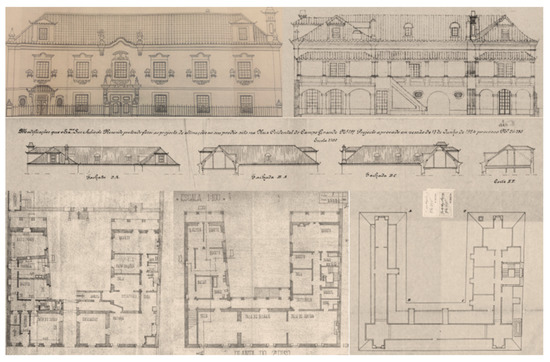
Figure 5.
Old drawings of the building.
The detailed architectural survey and visual inspection that were carried out prior to the establishment of the proposal for the refurbishment of the building were essential to the overarching aim of sustaining a satisfactory reconversion solution for the preservation of the architecture and the safeguarding of patrimonial values.
The three-dimensional photogrammetric digital survey methodology was integrated into the operational workflow of the case study following these steps: survey photographs taken from different perspectives, a drawing survey, and inspection work. This last step allowed the inclusion of constructive and destructive actions that were found in the building.
A digital capture of images was first performed to support the analyses of a rehabilitation design proposal for the building. A large range of photographs was taken with two main objectives: to later accurately define the exact geometry of the principal details of the house that are unique and characteristic of the epoch of its construction; and to properly show the real state of the conservation of the building. In addition, a drawing survey was considered and a set of detailed sketches was obtained. The architectural elements were modelled based on the identification of the geometry used in the design of parametric objects. The photogrammetric survey consisted of obtaining photographs from distinct perspectives, and these were adjusted to an adequate scale to allow for correct dimensioning. Under HBIM, this process was used to achieve a high level of geometric detail of the buildings’ components and decorative elements, in order to allow rigorous parametric object generation. The rigor of the modelling process was followed not only outside, but also inside the house (Figure 6).
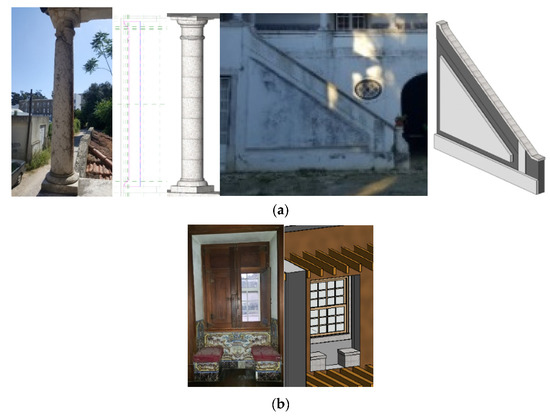
Figure 6.
Real geometry and parametric objects: (a) outdoor (b) indoor.
Historical buildings are usually characterised by the overlapping of construction interventions carried out in remodelling projects that take place over time. In this case, several drawings were found that revealed reconstructions designed to create a more modern and adequate house for the family of the new owners. The inspection work undertaken in an early stage of the design study showed the presence of different materials or architectural historical features, and the anomalies caused by the occupation of the house and the infiltration of water. The analysis covered the study of constructive and destructive actions found in the building (Figure 7).
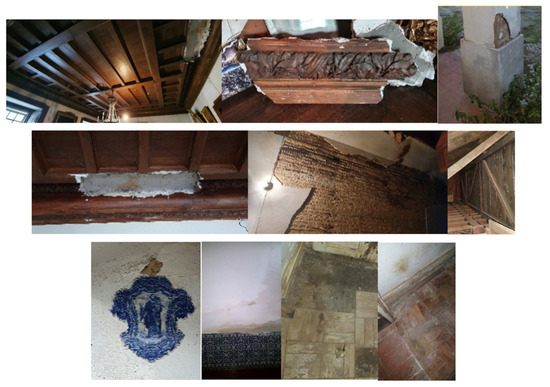
Figure 7.
Anomalies found in floor, ceilings, roof, and walls.
3.3. Phase 3 BIM Model Development
The building of heritage value presents characteristics identical to those of other buildings of the city of Lisbon that distinguish the classical construction style of the turn of the 20th century. The decorative finishes of stonework, commonly used in such houses, demonstrate a traceable route whereby classifications could be determined using historical specifications. To generate an HBIM model of the building, a rigorous modelling process was required to accurately represent the most remarkable architectural characteristics. To support this task, a library of specific families was created because the most used BIM-based software does not allow the strict representation of elements in the necessary detail.
3.3.1. Development of Specific Parametric Families
The refurbishment study of the building, which began with the discovery and collation of copied documents from the Municipal Archive of Lisbon, is dated 1924, and includes the report of the changes made over time, and drawings with yellow and red markings referring to 1953 (Figure 8).

Figure 8.
Drawings of yellow and red indicators, and images of damage.
To generate the objects corresponding to the opening elements included in the façades and the ornamentation of stonework framing these elements, a set of graphic notes and sketches (Figure 9) and a photographic survey were carried out, both inside and outside the building. In addition, the state of the maintenance of the building components, in particular the weight-bearing elements and the floor and wall coverings, were inspected.

Figure 9.
Sketches of a guillotine window made in the building.
A rigorous modelling process was undertaken to generate a library of specific families. The BIM-based tool used allows the generation of such specific families and their archives to establish a reusable library in the modelling of buildings of identical typology and epoch. Although the modelling process was time consuming, the chosen BIM modelling system, Revit (Autodesk, San Rafael, CA, USA), features a relevant library of common building components. For the present case, the modelling process was applied to the generation of proper roofs, walls and floors, windows and doors, and staircases and handrail elements.
Walls
The façades, composed of limestone masonry and with a thickness of about 0.60 m, are vertical self-healing elements with the capacity to resist vertical and horizontal forces, and confer a high internal thermal comfort, adequately protecting the interior of the building from the action of atmospheric agents. The walls form a solid structure and are positioned over a longitudinal solid foundation. It was possible to observe on site that the paintwork on surfaces showed several areas of damage caused by peeling (Figure 10).

Figure 10.
Decorative ceramic tiles applied to wall surfaces and detection of deterioration.
The photographic survey revealed the use of tiles as decorative and protective covering on the exterior and interior surfaces of the façades. During the on-site inspection, some deterioration was detected in the surface coverings of the façade walls, throughout the exterior and interior of the house, related to the plaster, and probably caused by water infiltration and the adverse action of the atmospheric agents (Figure 10).
The composition of the materials and layers of the walls varies depending on their location within the building, and includes ordinary masonry, brick, and mud walls. The plans provided by the Lisbon Municipal Archive include inconsistencies in terms of the thickness of the interior walls compared to the measurements made on site, and the descriptive annotations make no reference to the type of material used. The inspection enabled the following identification and measurement of the varying widths (Figure 11): the ordinary masonry wall (blue) with an average thickness of 0.275 m; the brick wall (red) with a thickness of 0.25 m; and the mud wall (yellow) with a thickness of 0.20 m.

Figure 11.
Plans of the three levels showing distinct types of walls.
The ground floor walls are shown as having a thickness of 0.630 m on the façades that surround the interior courtyard, whereas on the façade facing the public road and the side, the walls are 0.615 m thick. On the second floor, the whole wall is uniformly 0.615 m thick. The wall is composed of several layers: a structural component made of limestone, peripheral layers made of clay mortar and sand-lime, and a covering made of plaster material. Using Revit’s parametric object library, a new wall and the lower foundation were created. For this purpose, a stacked wall object, which is included in the wall system family, was selected, allowing the wall to be positioned over the longitudinal foundation element (Figure 12).

Figure 12.
Generation of a parametric object representing a structural wall and its foundation.
The modelling process of the façade walls was carried out with the application of the new parametric object along the alignments, and taking into consideration the height of each wall from the level of the foundations to the lower level of the roof (Figure 12).
Windows and Doors
Several different types of windows can be seen in the façades of “Casal de São José” (Figure 13). The guillotine window, of French origin, from the 19th century, has a simple design, providing the maximum light and resistance to winds. However, these windows are relatively narrow. They are composed of two panels each, with 6 to 15 glass panes, which pass smoothly over each other, in the vertical direction. The opening mechanism, formed by cords and counterweights situated at the sides of the window frame, allows the windows to be partially opened.
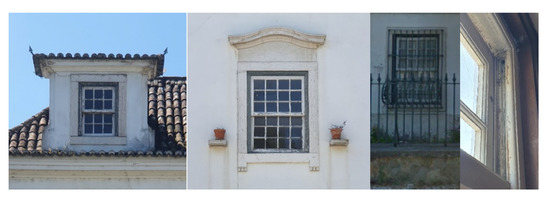
Figure 13.
Distinct type of guillotine windows present in the main façade.
The BIM modelling system features a library of windows applicable in common buildings; however, the guillotine window has a distinct typology and, in this building, the stonework surrounding each window also presents particular details that had to be accurately represented in an HBIM context (Figure 14).

Figure 14.
Reduction of the wall thickness (extrusion) and definition of lateral details (sweep).
To illustrate the modelling process of a specific family of a construction component, a guillotine window was generated. This process was supported by a set of pictures taken in situ and by detailed sketches also drawn in the building. The old drawings found in the municipal entity were also consulted but the information included there was limited and lacking in detail (Figure 14).
The used BIM-based tool, Revit, features a library of windows of new buildings. However, the guillotine window presents significant geometric differences, thus necessitating the creation of a new family of windows. The methodology used to generate the guillotine window followed this sequence of steps: (1) the definition of an opening within a generic wall with the dimensions collected on site; (2) the modelling of the surrounding elements to support the placement of the window frame (side jambs and sill); (3) and the generation of the two panels that make up the window.
- 1.
- In the initial interface of the BIM-based tool, a new window family option was selected. The definition of a window requires a support wall, which had to be adapted to the desired thickness (615 mm). An opening was inserted in it and adjusted to the desired size of the window (1400 × 1650 mm). Under the window, the thickness of the façade wall was reduced to 180 mm and, according to the sketches, the opening presented the necessary intricate details, as shown in the records. To reduce the thickness, an extrusion operation was applied towards the inner surface of the wall to the outside, with a thickness of 435 mm. A chamfer shape that runs along the side jambs and lintels was then defined. Finally, an extraction of a rectangular section (sweep) was performed on the outside of the wall to accommodate the window jamb stone.
- 2.
- Following the creation of the opening, the surrounding window placement zone was defined. The on-site sketches of the granite stonework elements around the window were the basis of this part of the modelling process. A frame with a section of 200 by 220 mm was created, and the detail of the window jamb was modelled using the sweep function. The sill, which is the horizontal element on which the lower panel of the window is positioned, required a rigorously accurate redrawing using a graphic system because of the great detail of its form. This element was shaped using the extrusion option (Figure 15).
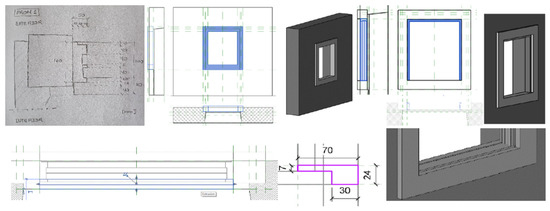 Figure 15. Modelling of surrounding stonework elements.
Figure 15. Modelling of surrounding stonework elements. - 3.
- Finally, the two panels that make up the window were generated. The sketches drawn on site presented precise geometric details regarding the composition of the frame elements, and the internal division encasing the glass panes. The panels are shown as identical and are placed in parallel, with an overlap of 70 mm. Thus, the definition of the geometry of the outer frame was supported by the detailed forms that were previously established using the extrusion command (Figure 16).
 Figure 16. Modelling of two panels of the guillotine window.
Figure 16. Modelling of two panels of the guillotine window.
On the front façade, the guillotine window positioned over the main door features decorative elements in the stonework surrounding the window, composed of a sill, side pins, pediments, and other details (Figure 17). The generation of each element required the establishment of a specific modelling process. First a profile form was defined and then, to obtain the required forms, a revolution or a sweep operation following a precise path was applied.

Figure 17.
Modelling of decorative stonework elements around the window.
Following the generation of all of the decorative and functional elements of the main guillotine window, the respective materials and their correct mechanical and physical properties were added to the new parametric family of windows. The window panel frames and their outer-frame elements are made of oak, with glass panes, and the surrounding ornamentation is made of granite (Figure 18).

Figure 18.
The guillotine window: picture and model.
Although all of the remaining guillotine windows are similar, their modelling required an additional amount of time-consuming work due to differences in their individual details. For this purpose, several types of windows were also created. These all required a similar modelling process because some or all of the aspects of size, thickness, geometry, or height differed from those of the guillotine window modelled first (Figure 19).

Figure 19.
Oval and other guillotine windows.
A similar modelling process was carried out based on the photographic survey and the set of sketches made on site, and using the capacities of the BIM-based tool. All windows in the building were modelled. At this stage, these new families were part of the window library of the system (Figure 20).

Figure 20.
New library of distinct window families.
Doors
A similar modelling process was applied to the generation of distinct families of doors (Figure 21). The doors of the building have their own, particular characteristics compared to a stereotypical door. The specific details of each interior and exterior door differ in terms of the door’s particular geometry, the partition of the glazed area, and the frame elements around the door. In addition, the surrounding granite of the exterior doors presents highly detailed stonework that required an accurate modelling process.

Figure 21.
Distinct families of doors were generated.
As shown in Figure 22, the finished, defined guillotine window was composed of an opening correctly inserted into the wall; highly accurate definition of the frame and sill; proper representation of the two window panels; and modelling of the set of ornamental stone elements. The guillotine window family was inserted into the windows library, making it available for use in work on the building façade. Finally, all generated families of specific parametric objects were applied to the model.

Figure 22.
Complete windows and the principal door in the main façade.
Staircases and Handrails
The balconies are external construction components, located on the rear courtyard of the building, and essentially composed of brick masonry and ordinary stone floors with ceramic finishing. The staircase provides access to the raised floor. It is made of stone and complemented by handrail elements in granite stonework. During the initial inspection, some deterioration, possibly due to the disaggregation of the plaster, was observed on the surface and the columns that support the balconies
The following elements were modelled and inserted into the HBIM model: the stone staircase, located at the rear of the house and formed by a single flight of stairs parallel to the rear façade; the columns supporting the balconies; the rear access handrail; and some decorative elements in stone, such as pilasters, visible outside the roof of the main façade of the building (Figure 6 and Figure 23).

Figure 23.
Models of balcony, arcs, the handrail, and the pilaster visible in the rear façade.
Inside the building, there are several wooden staircases, limited by square configuration boxes, and providing access from the ground floor to the upper level and the attic. This whole structure, including the steps and all of the elements of the balustrade (the handrail supported by the balusters and the base rail), has detailed and well-constructed woodwork throughout. In addition, an interior service staircase with a single flight, also made of wood, gives access to the service area from the ground floor to the upper floor. During the visual inspection, no relevant deterioration in condition was identified (Figure 24).
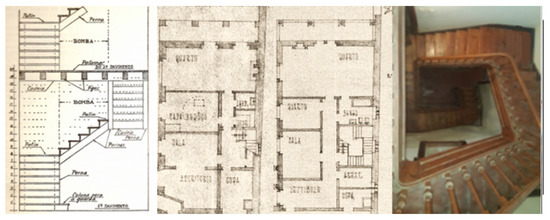
Figure 24.
Drawings, pictures and model of interior wooden staircase.
Floors
The floors of the building were seen to vary in composition, depending on the location within the building, i.e., ground or upper floors. Based on contemporaneous historical records of the traditional construction solutions, the ground floor is probably composed of a sequence of layers, consisting of sand or clay material with a thickness of about 10 cm, placed directly over the ground foundation, followed by a layer of poured concrete with a thickness of about 20 cm, and an upper layer of screed, finished with ceramic tiles or wooden coverings (Figure 25). The ground floor presents some signs of wear and cracking, due to use and the lifting of the wooden elements of the covering caused by water infiltration.

Figure 25.
Composition of the ground floor, covered with wooden elements and ceramic tiles.
The structure and flooring elements of the upper levels and attic are made of wood. The flooring is formed by edge-joining planks or blocks, which, following the English practice, uses the system of male–female lateral union: the planks are prepared with, on one side, a bead and, on the other, a groove, which fit together forming a flat covering surface. The flooring blocks or planks are placed according to their different dimensions and positions (Figure 26) to form the desired geometric patterns. The main supporting beams are positioned according to the narrowest dimension of each section of the house, and their ends are placed with a short length extending into the adjacent façade wall.

Figure 26.
Wooden structure of the raised floors.
The plaster stucco, which is decorative art associated with the construction industry, was applied to the ceilings of the main rooms of the building, presenting a simple or more elaborate configuration, such as crown moulding near the edges of the ceiling surface, or floral plaster at its centre. This ancient technique is of Italian origin, and affirms the grandeur of the building, displaying a more artistic decorative complexity. The visual inspection revealed the existence of some deterioration in the ceilings, essentially observed as damage to the plaster, namely, cracking of both smooth surfaces and those with relief work highlighted by plaster fragments (Figure 7).
Using the floor function of the BIM-based software, the ground floor was modelled. It was composed of a layer of screed, a layer of concrete, and three layers of sand that followed the basic dimension of the foundations. The structure of the upper floor is formed of wooden longitudinal beams, spaced 40 cm apart, and of transversal beams with a cross-section of 22 cm (Figure 27).
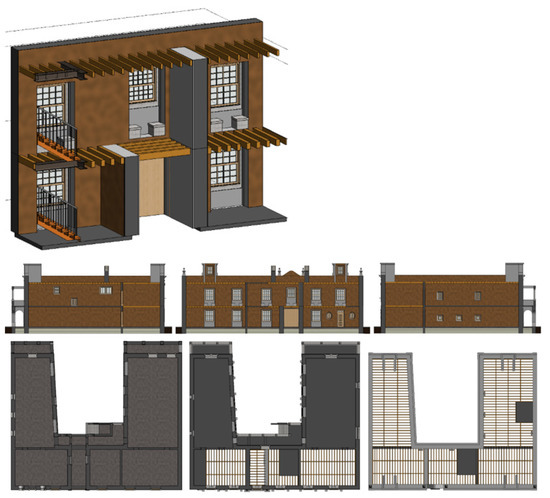
Figure 27.
Interior detail of the model, elevations, and plants of all levels.
Roof
The building has a typical Portuguese, sloped, wooden roof composed of triangular sections, with a variable pitch of between 30° and 35°, forming the weight-bearing structure (Figure 28). The wooden element is a simple geometric form, i.e., triangular, formed by a horizontal baseline, representing the beam, and two sloped sides, the rafters, and a vertical median line. The triangular structures are placed equidistantly, providing a suitable construction solution for the support of the roof, which is composed of three main blocks that follow the geometric U-shape shown in the floor-plan. The interior of the attic, which is limited by the structure of the roof, has variable headroom, although this is sufficient in the central area to be usable. However, as the interior facing is made of wood, the comfort needed as a living-space is reduced; as a result of external heat, a greenhouse effect is often created inside and in the winter the space is humid and cold.

Figure 28.
Drawings and pictures of the roof.
The attic area was conceived of as a living-space. Thus, to let in natural light from the outside, a dormer-like structure, “águas furtadas” in Portuguese, was constructed. This is a construction that protrudes vertically from the pitched plane of a roof, covered with ceramic tiles, and with a window at the top. The front-facing living areas, which form the sides of the dormer, stand on reinforced beams. The pitch of the roof, near the eaves, allows the median line to be changed to create a softer angle, because the inflection line, in geometric terms, is by definition referred to as galbo. The resulting valley, in architectural terms, has the function of protecting the walls of the façades from rainwater draining directly from the roof, thus preventing them from becoming blackened (Figure 29). From the outside, on the tiles and mainly in the galbo or valley zones, the presence of plants, such as lichens, were observed.
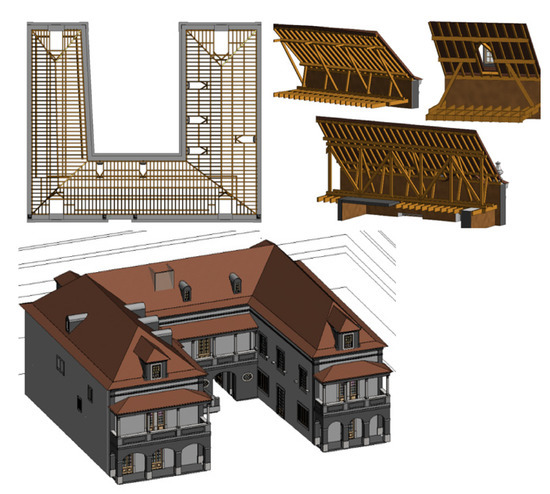
Figure 29.
Model of the roof.
The modelling process of the roof was thoroughly analysed, with particular reference to the complexity of the structure composed of wooden elements. The roof consists of principal pitches, parallel to all façades, and top water plans, located at the ends of the building, parallel to the balconies of both sides. The modelling process was based on the use of parametric objects included in the roof menu, available in Revit (Figure 29).
The interior structure of the building presents a distinctly different organization between each of the mansion blocks, and also significant differences when compared with the old drawings consulted. The geometric information required to generate the roof model, however, was obtained from on-site photographs and sketches. The roof model component complements the HBIM expansion in progress (Figure 30).
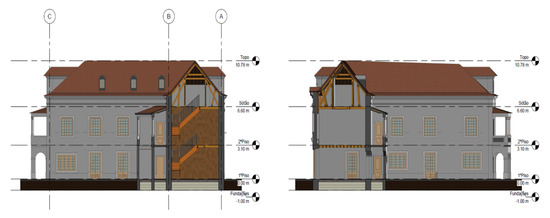
Figure 30.
Details of the roof incorporated in the HBIM model.
3.3.2. Materials
The final HBIM product should be a complete 3D geometric model, including rigorous geometric details, the identification of the materials used, and the construction methods applied. The generated families of parametric objects for each particular heritage building requires the addition, to the respective parameters of each object, of the correct representation of the building details, in addition to the evaluation of the state of the physical properties. The specification of materials and texture can be established according to the required physical properties that are representative of the old materials used in historical buildings.
In the present case, the information collected from old drawings and from in situ inspection allowed the materials to be identified: the façade walls are made of limestone masonry; the inner and outer coating consists of clay and lime mortar; the ornamental elements of the windows and exterior doors are of granite blocks; the doors and respective frames are made of wood, as are the inner and outer window frame elements; the individual transparent window panes are made of glass. This information is an essential complement to the generation of parametric objects as details of the material applied and the evaluated state of the physical properties.
3.3.3. Final Conversion Proposal: BIM Model, Archive of Documentation, and Hierarchy of Information
The HBIM architectural model required a large and detailed geometric study, in addition to time-consuming on-the-job familiarization and training in the advanced capabilities of the selected system. Following its completion, the model was used as the basis for the development of the proposed refurbishment study (Figure 31).
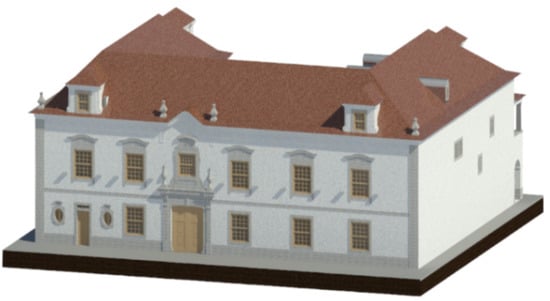

Figure 31.
Final architectural model.
The proposed refurbishment project for the building concerns the internal reorganization of the divisions into four individual apartments (Figure 32), in a manner that preserves the building’s patrimonial and cultural value. In the interior of the building, a new layout of the rooms was established that involved the replacement of the wooden floor with a mixed slab of steel–concrete structures. The model was used to derive several alternative refurbishment solutions. On each storey, the interior walls established for the new apartments were modelled, according to the proposed repurposing project. All of the interior doors were reused, and, in the attic, new doors were designed using the current library of the software. The elaboration of the proposal is described in the report of Pinto [9].
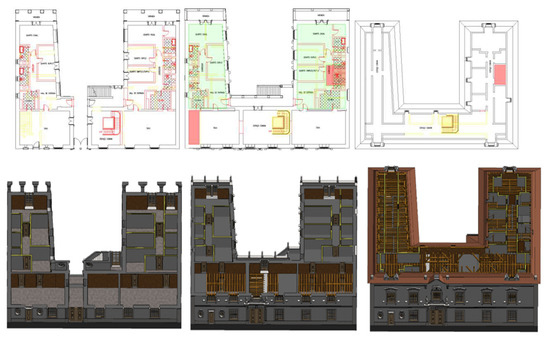
Figure 32.
The BIM model of the proposed conversion of the building.
An HBIM model can be created to allow the incorporation of parameters with different types of information, which is organised by the historical stages of construction and archived as layers of distinct data, forming a hierarchical and chronological sequence of information. This model is called an as-built model, in which the model is composed of several “ages” of information, facilitating the retrieval of heterogeneous information related to the history of the building. Management and conservation represent crucial phases within the life-cycle of the historical building. However, the complexity of the preservation practices and the lack of knowledge of historic buildings are limitations that are normally found in heritage studies [32].
3.3.4. Model of the New Structural Design Based on the HBIM Model
The proposed remodelling involves an architectural study that led to the establishment of a project. The primary objective of the project was to design and analyse a structural solution of a composite slab, using patterns of digital data exchange between BIM-based programs. The project aimed to drive the implementation of BIM methodology in construction projects of heritage buildings in Portugal, both through the development of libraries for families of certain intelligent objects, and strategies to overcome the inherent limitations of the degree of interoperability found in the case study.
The architectural intervention study was carried out based on the correct representation of the building, and conversion drawings were created that identified the elements to be demolished (yellow), to be built (red), and to be replaced (green) for the different floors, as shown in Figure 32. In this context, the most relevant structural intervention corresponds to the replacement of the wooden section of the raised floor, which may not provide the necessary resistance to support the new distribution of interior walls, with ceramic masonry, and the coating of the wet areas with hydraulic tiles, which results in a weight increase. The BIM model was created so that it is able to accurately represent the stonework details of windows, doors, and friezes on the façade, in addition to the supporting walls on which the decorative elements are applied. Then, the new structural solution, which was designed as a composite slab, was also modelled (Figure 33).
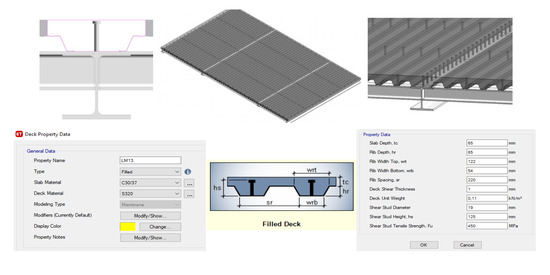

Figure 33.
Modelling process of the composite slab.
The BIM model of the new structure replaces the wooden floors of the building’s side wings. This solution involved a pre-dimensioning, which started with the parameterization of the structural model in Revit. The composite slab consists of rolled or built-up structural steel beams and cast in situ concrete floors. These are connected using shear connectors in such a manner that they act monolithically. Composite deck slabs are particularly competitive in cases in which the concrete floor has to be completed quickly and where a moderate level of fire protection for the steel work is sufficient.
In an academic context, only a lateral upper floor was modelled and submitted to a structural analysis. The steel beams are positioned in an orthogonal direction: longitudinal HE160B (purple), and for the ribs perpendicular to them, HE280B main beams (green). The secondary beams are simply supported on the main beams, in addition to the main beams on the masonry walls. Regarding the steel connections established between the secondary beams and the main beams, it was not possible to transfer the connection geometry (Figure 34).
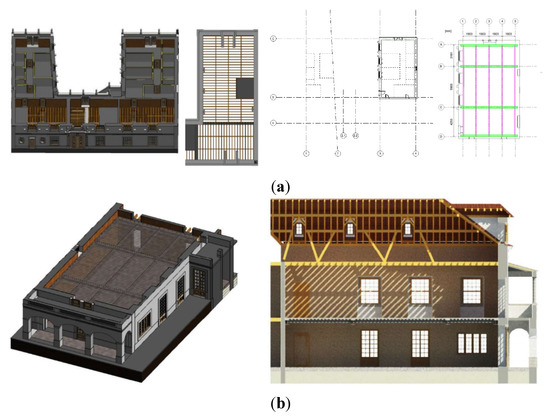
Figure 34.
(a) The lateral upper floor was replaced by a composite slab. (b) Model with the new structure.
As previously mentioned, the modelling process was based on the study of existing graphic documents from the Lisbon Municipal Archive, drawn sketches, and photographic records. These documents should be associated with the model for further consultation, not only to support the specialists involved, but also to provide a complete base to underpin decisions about alternative solutions. Professionals involved in the preservation or rehabilitation activity can develop their work based on the capabilities inherent in the most commonly used BIM-based tools, by operating on the HBIM model. This documentation was able to be included in the project using the ability of the BIM systems to import distinct types of file formats. Figure 35 includes sheets directories of drawings (dated 1953) and photography taken during the inspection visit to the location (dated 2019).
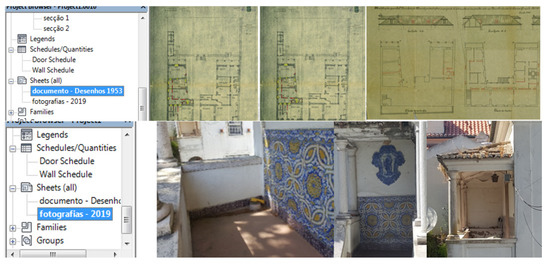
Figure 35.
Archive of documentation within the HBIM model.
4. Discussion
The text describes the modelling process of the generation of specific building components related to a building of patrimonial value, namely, the “Casal de São José”, which is representative of the predominant architecture of the early 20th century. In this work, a rehabilitation project was developed with the aim of studying the implementation of the BIM methodology for buildings of patrimonial value. The rehabilitation project was based on the conversion of a single-family house into four apartments each for individual use. In the context of the present work, the conversion of a building of significant patrimonial value was proposed, in addition to the alteration of the internal organization of its compartmentalization.
The intervention study of the building was based on the HBIM methodology, and required a rigorously exact and comprehensive definition of the building’s architecture. For this purpose, old drawings, photographs, and sketches were first collected. It is a challenge to model a building with specific characteristics using only the generally available libraries. Thus, a set of families of architectural components was defined that allowed the accurate representation of the building “Casal de São José”. These tools allowed parametric modelling of significant architectural details, resulting in the generation of new families of façades, wooden floors, staircases, and the roof, and their ornamental stonework elements. The object tool also allowed the incorporation of the physical properties of the materials used in the real building.
Our 3D modelling approach is based on photogrammetry combined with topographic and empirical measurements. This technique is inexpensive and precise but consumes a large amount of time. The scientific literature shows different approaches to HBIM methodologies and 3D geometric modelling using point clouds [33,34,35,36]. Semiautomatic and automatic approaches to obtain 3D geometric reconstructions of heritage buildings [37,38], and the use of BIM-FEM environments [27], may reduce the time and effort required, and thus simplify the development of structural studies.
This work contributes to increasing the scope of the library of construction components and, in particular, aims to support the work on HBIM projects. The HBIM concept has proven to be a highly interesting topic of research, and a useful application in real cases of rehabilitation, reconversion, and conservation.
Author Contributions
Conceptualization, Methodology and Supervision, A.Z.S. and A.M.G.; Investigation, Resources and Data Curation, A.M.P.; Methodology, Writing—Review & Editing, A.S.-L. All authors have read and agreed to the published version of the manuscript.
Funding
This research received no external funding.
Institutional Review Board Statement
Not applicable.
Informed Consent Statement
Not applicable.
Conflicts of Interest
The authors declare no conflict of interest.
References
- Sacks, R.; Koskela, L.; Owen, R. Interaction of lean and Building Information Modeling in construction. J. Constr. Eng. Manag. 2010, 136, 1943–7862. [Google Scholar] [CrossRef] [Green Version]
- Sampaio, A.Z. BIM concept and multi-use: nD/BIM models. In Proceedings of the International Congress on Engineering (ICEUBI2017), Covilhâ, Portugal, 5–7 December 2017; ISBN 978-989-405-8. [Google Scholar]
- Araújo, L. Development of Wall Library in BIM Methodology. Master’s Thesis, University of Lisbon, Lisbon, Portugal, 2016. [Google Scholar]
- Sampaio, A.Z.; Araújo, L. BIM concept: Generation of parametric objects of composed walls. In Proceedings of the Congress on Numerical Methods in Engineering (CMN 2019), Guimarães, Portugal, 1–3 July 2019; pp. 894–903, ISBN 978-989-5449-60-6. [Google Scholar]
- Apollonio, F.; Gaiani, M.; Sun, Z. 3D modeling and data enrichment in digital reconstruction of architectural heritage. In Proceedings of the International Archives of the Photogrammetry, Remote Sensing and Spatial Information Sciences (ISPRS), Beijing, China, 5–6 December 2013; Volume XL-5/W2, pp. 43–48. [Google Scholar] [CrossRef] [Green Version]
- Chevrier, C.; Charbonneau, N.; Grussenmeyer, P.; Perrin, J. Parametric documenting of built heritage: 3D virtual reconstruction of architectural details. Int. J. Architect Comput. 2010, 8, 131–146. [Google Scholar] [CrossRef]
- Prizeman, O.C. HBIM and matching techniques: Considerations for late nineteenth- and early twentieth-century buildings. J. Archit. Conserv. 2015, 21, 145–159. [Google Scholar] [CrossRef]
- Sampaio, A.Z.; Lite, A.S.; Pérez, P.Z.; Gaya, C.G. BIM application in the conservation of buildings of patrimonial value. In Proceedings of the Meeting on Conservation and Rehabilitation of Buildings (ENCORE 2020), Lisbon, Portugal, 3–6 November 2020. [Google Scholar]
- Pinto, A.M. The Design of Structures in BIM: Reconversion of Building of Patrimonial Value. Master’s Thesis, University of Lisbon, Lisbon, Portugal, 2020. [Google Scholar]
- Bruno, S.; Fatiguso, F.; Dell’Osso, G.R.; Musicco, A. The role of 4D Historic Building Information Modelling and Management in the analysis of constructive evolution and decay condition within the refurbishment process. Int. J. Archit. Heritage 2019, 7. [Google Scholar] [CrossRef]
- Rivera, J. Tres restauradores de la arquitectura, boito, giovannoni y Torres Balbás: Interrelaciones en la Europa de la primera mitad del siglo XX. Conversaciones Rev. Conserv. 2018, 1, 155–175. [Google Scholar]
- Kristl, Ž.; Temeljotov Salaj, A.; Roumboutsos, A. Sustainability and universal design aspects in heritage building refurbishment. Facilities 2020, 38, 599–623. [Google Scholar] [CrossRef]
- Haroun, H.-A.A.F.; Bakr, A.F.; Hasan, A.E.-S. Multi-criteria decision making for adaptive reuse of heritage buildings: Aziza Fahmy Palace, Alexandria, Egypt. Alexandria Eng. J. 2019, 58, 467–478. [Google Scholar] [CrossRef]
- Radziszewska-Zielina, E.; Śladowski, G. Supporting the selection of a variant of the adaptation of a historical building with the use of fuzzy modelling and structural analysis. J. Cult. Herit. 2017, 26, 53–63. [Google Scholar] [CrossRef]
- Morkunaite, Z.; Podvezko, V.; Zavadskas, E.K.; Bausys, R. Contractor selection for renovation of cultural heritage buildings by PROMETHEE method. Arch. Civ. Mech. Eng. 2019, 19, 1056–1071. [Google Scholar] [CrossRef]
- Nadkarni, R.R.; Puthuvayi, B. A comprehensive literature review of Multi-Criteria Decision Making methods in heritage buildings. J. Build. Eng. 2020, 32, 101814. [Google Scholar] [CrossRef]
- Jordan-Palomar, I.; Tzortzopoulos, P.; García-Valldecabres, J.; Pellicer, E. Protocol to Manage Heritage-Building Interventions Using Heritage Building Information Modelling (HBIM). Sustainability 2018, 10, 908. [Google Scholar] [CrossRef] [Green Version]
- Turskis, Z.; Morkunaite, Z.; Kutut, V. A hybrid multiple criteria evaluation method of ranking of cultural heritage structures for renovation projects. Int. J. Strateg. Prop. Manag. 2017, 21, 318–329. [Google Scholar] [CrossRef] [Green Version]
- Gonçalves, J.; Mateus, R.; Silvestre, J.D.; Roders, A.P.; Vasconcelos, G. Selection of Core Indicators for the Sustainable Conservation of Built Heritage. Int. J. Archit. Herit. 2021, 1–16. [Google Scholar] [CrossRef]
- Bruno, N.; Roncella, R. HBIM for Conservation: A New Proposal for Information Modeling. Remote Sens. 2019, 11, 1751. [Google Scholar] [CrossRef] [Green Version]
- Diara, F.; Rinaudo, F. Building Archaeology Documentation and Analysis through Open Source HBIM Solutions via Nurbs Modelling. Int. Arch. Photogramm. Remote Sens. Spat. Inf. Sci. ISPRS Arch. 2020, 43, 1381–1388. [Google Scholar] [CrossRef]
- Trizio, I.; Savini, F.; Giannangeli, A.; Boccabella, R.; Petrucci, G. The Archaeological Analysis of Masonry for the Restoration Project in HBIM. In Proceedings of the 8th Intl. Workshop 3D-ARCH “3D Virtual Reconstruction and Visualization of Complex Architectures”, Bergamo, Italy, 6–8 February 2019; The International Archives of the Photogrammetry, Remote Sensing and Spatial Information Sciences, 2019; Volume XLII-2/W9, Available online: http://bussola.s3.amazonaws.com/696104/isprs-archives-XLII-2-W9-715-2019.pdf (accessed on 25 July 2021).
- Sztwiertnia, D.; Ochałek, A.; Tama, A.; Lewińska, P. HBIM (heritage Building Information Modell) of the Wang Stave Church in Karpacz—Case Study. Int. J. Archit. Herit. 2021, 15, 713–727. [Google Scholar] [CrossRef]
- Ponte, M.; Bento, R.; Silva, D.V. A multi-disciplinary approach to the seismic assessment of the National Palace of Sintra. Int. J. Archit. Herit. 2019, 22, 757–778. [Google Scholar] [CrossRef]
- Martínez-Carricondo, P.; Carvajal-Ramírez, F.; Yero-Paneque, L.; Agüera-Vega, F. Combination of nadiral and oblique UAV photogrammetry and HBIM for the virtual reconstruction of cultural heritage. Case study of Cortijo del Fraile in Níjar, Almería (Spain). Build. Res. Inf. 2020, 48, 140–159. [Google Scholar] [CrossRef]
- Quattrini, R.; Malinverni, E.S.; Clini, P.; Nespeca, R.; Orlietti, E. From TLS to HBIM. High quality semantically-aware 3D modeling of complex architecture. Int. Arch. Photogramm. Remote Sens. Spat. Inf. Sci. 2015, XL-5/W4. [Google Scholar] [CrossRef] [Green Version]
- Pepe, M.; Costantino, D.; Restuccia Garofalo, A. An Efficient Pipeline to Obtain 3D Model for HBIM and Structural Analysis Purposes from 3D Point Clouds. Appl. Sci. 2020, 10, 1235. [Google Scholar] [CrossRef] [Green Version]
- Sampaio, A.Z. Preservation of constructive techniques in a museum and didactic context. In Proceedings of the Heritage Rehabilitation Congress (CREPAT 2017), Aveiro, Portugal, 29–30 June 2017; pp. 729–737, ISBN 978-989-207623-2. Available online: https://www.ua.pt/pt/crepat/ (accessed on 27 July 2021).
- Murphy, M.; McGovern, E.; Pavia, S. Historic Building Information Modelling: Adding intelligence to laser and image based surveys of European classical architecture. ISPRS J. Photogramm. Remote Sens. 2013, 76, 89–102. [Google Scholar] [CrossRef]
- Genovez, S.C. Stratigraphic Analysis: A Contribution to the Restoration Project. Master’s Thesis, University of São Paulo, São Paulo, Brazil, 2012. [Google Scholar]
- Brumana, R.; Torre, S.D.; Previtali, M.; Barazzetti, L.; Cantini, L.; Oreni, D.; Banfi, F. Generative, HBIM modelling to embody complexity (LOD, LOG, LOA, LOI): Surveying, preservation, site intervention—The Basilica di Collemaggio (L’Aquila). Appl. Geomat. 2018, 10, 545–567. Available online: https://link.springer.com/article/10.1007/s12518-018-0233-3 (accessed on 27 July 2021). [CrossRef]
- Osello, A.; Lucibello, G.; Morgagni, F. HBIM and virtual tools: A new chance to preserve architectural heritage. Buildings 2018, 8, 12. [Google Scholar] [CrossRef] [Green Version]
- López, F.J.; Lerones, P.M.; Llamas, J.; Gómez-García-Bermejo, J.; Zalama, E. A Review of Heritage Building Information Modeling (H-BIM). Multimodal Technol. Interact. 2018, 2, 21. [Google Scholar] [CrossRef] [Green Version]
- Messaoudi, T.; Véron, P.; Halin, G.; De Luca, L. An ontological model for the reality-based 3D annotation of heritage building conservation state. J. Cult. Herit. 2018, 29, 100–112. [Google Scholar] [CrossRef] [Green Version]
- Brumana, D.; Oreni, L.; Barazzetti, B.; Cuca, M.; Previtali, F. Banfi, Survey and scan to BIM model for the knowledge of built heritage and the management of conservation activities In Transformation of the Design, Construction and Management Processes of the Built Environment. Research for Development; Daniotti, B., Gianinetto, M., Della Torre, S., Eds.; Digital Springer: Cham, Switzerland, 2020; pp. 391–400. ISBN 978-3-030-33570-0. [Google Scholar]
- Yang, X.; Lu, Y.C.; Murtiyoso, A.; Koehl, M.; Grussenmeyer, P.; Yang, X.; Lu, Y.C.; Murtiyoso, A.; Koehl, M.; Grussenmeyer, P. HBIM modeling from the surface mesh and its extended capability of knowledge representation. ISPRS Int. J. Geo-Inf. 2019, 8, 301. [Google Scholar] [CrossRef] [Green Version]
- Croce, V.; Caroti, G.; De Luca, L.; Jacquot, K.; Piemonte, A.; Véron, P. From the Semantic Point Cloud to Heritage-Building Information Modeling: A Semiautomatic Approach Exploiting Machine Learning. Remote Sens. 2021, 13, 461. [Google Scholar] [CrossRef]
- Andriasyan, M.; Moyano, J.; Nieto-Julián, J.E.; Antón, D. From Point Cloud Data to Building Information Modelling: An Automatic Parametric Workflow for Heritage. Remote Sens. 2020, 12, 1094. [Google Scholar] [CrossRef] [Green Version]
Publisher’s Note: MDPI stays neutral with regard to jurisdictional claims in published maps and institutional affiliations. |
© 2021 by the authors. Licensee MDPI, Basel, Switzerland. This article is an open access article distributed under the terms and conditions of the Creative Commons Attribution (CC BY) license (https://creativecommons.org/licenses/by/4.0/).